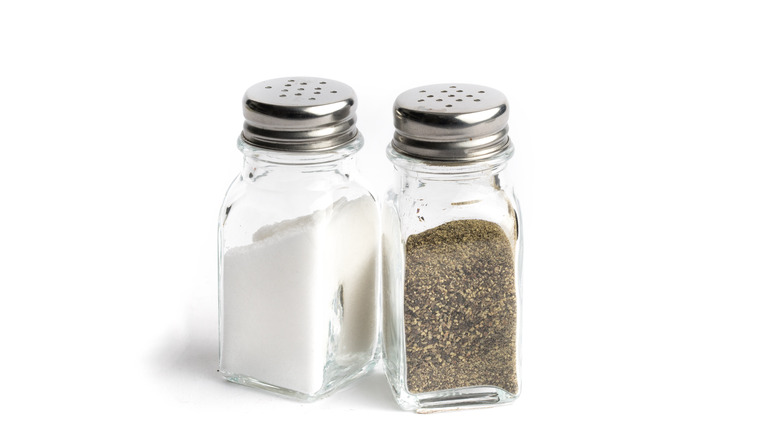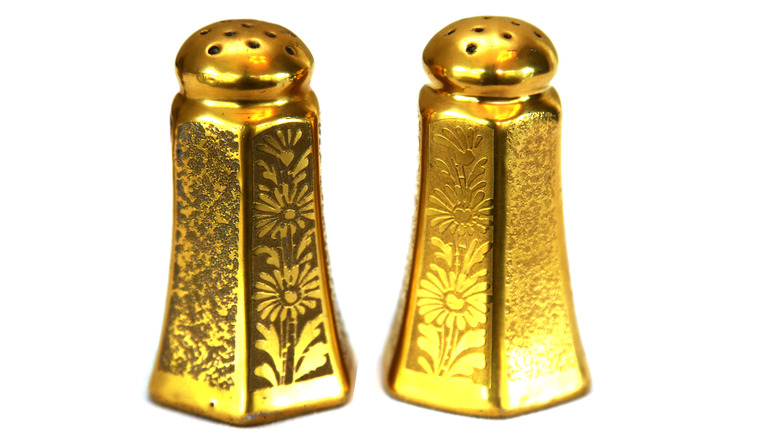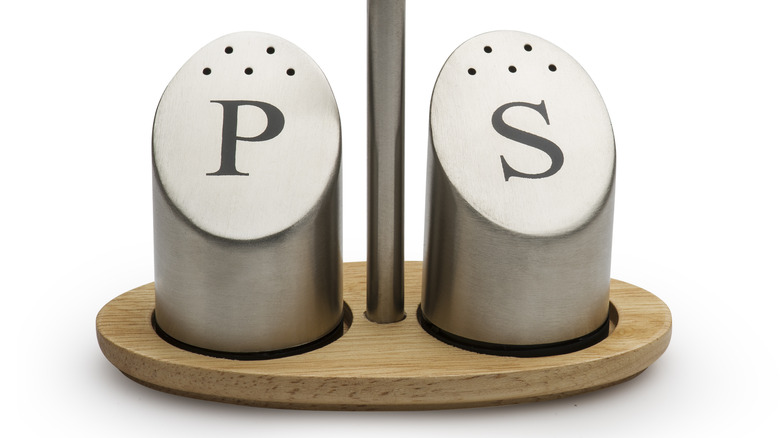The Intriguing History Of Salt And Pepper Shakers
Whether you're sitting at home, in a booth at your local diner, or in a fancy restaurant, chances are a pair of salt and pepper shakers are within reach. One might assume that salt shakers at least have been around forever. After all, History reminds us that salt has been a popular method for preserving food since Ancient Egypt. But that would not be the case. While variations on what a modern crowd might call salt shakers go back hundreds of years, its contents' tendency to cake up and lump made them impractical.
The earliest known salt shaker debuted in 1858, shares The Intelligencer, and was credited to John Mason, who was also the inventor of the mason jar. Despite this revolutionary design, it still took more than 60 years for salt shakers to break into the mainstream and become the kitchen table staple they are today. According to Smithsonian Magazine, before the 1920s the average person kept salt in a small bowl, like a salt cellar. The seasoning was usually served with a spoon, as it had a tendency to clump up due to moisture (it's for this same reason some diners add rice to their salt shakers). But one decision by a big player the salt industry changed this practice forever.
Salt shakers break into the mainstream.
According to the Made In Chicago Museum, the Morton Salt Company introduced magnesium carbonate into its already popular salt in 1911. The introduction of this revolutionary ingredient prevented salt from clumping and allowed it to be more easily poured out — and thus the salt shaker went mainstream.
It didn't take long for salt shakers to spawn pepper shakers, capitalizing on their co-dependent culinary relationship. (Smithsonian Magazine notes that, as pepper doesn't suffer the same moisture issues as salt, the spice really never needed to be served in a bowl in the first place, but people simply did so because they were accustomed to using the two as a pair.)
Now is there a real difference between salt and pepper shakers? The Salt and Pepper Shaker Museum (more on that later) sheds some light on the great debate, ultimately deciding it depends on where you're from, what's inside, and what your goals are. Some people insist on salt being in the shaker with fewer holes, while others are adamant it should be the other way around. The right decision is the one that works best for you.
Salt shakers do more than add flavor
Salt and pepper shakers quickly became staples of the western culinary world, but Smithsonian Magazine states that they really took off when the automobile became more prevalent. Alex Ludden of Tennesee's Salt and Pepper Shaker Museum told the outlet that people began collecting novelty shakers while traveling as souvenirs, as they were easy to transport and relatively inexpensive. The expert states that the Great Depression also played a part in the popularity of using salt and pepper shakers as a decorative item for similar reasons. Before long, cookware companies and local craftspeople began making their own versions to get in on the trend.
Now, salt and pepper shakers are seen as collector's items that some use as conversation pieces and decorum, a seasonal way to express yourself — be it through a turkey-shaped set at Thanksgiving or the expensive crystal ones used only on special occasions.
As mentioned above, there is even a museum dedicated to celebrating the shakers! Andrea Ludden, a Belgian archaeologist and parent of expert Alex Ludden, started the Salt and Pepper Shaker Museum after her collection became too big to handle. Now, the museum boasts over 20,000 salt and pepper shakers, including a prototype from the 1500s. In the end, the fact that there's a small museum devoted to their impact shows that the shakers don't just add flavor to food — they add flavor to conversations, ambiance, and the table they call home.


